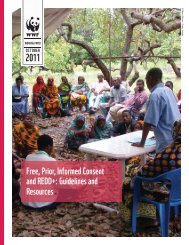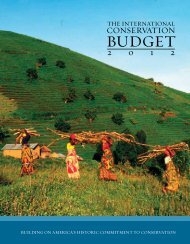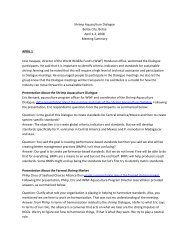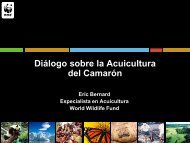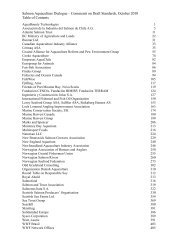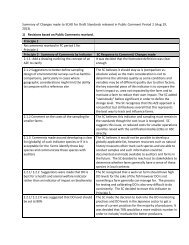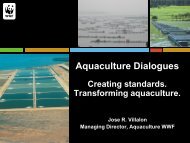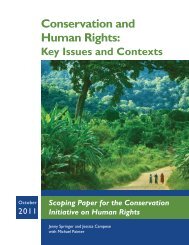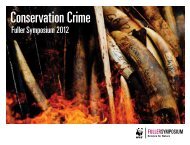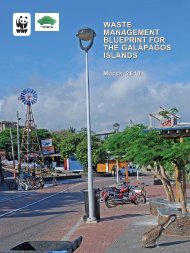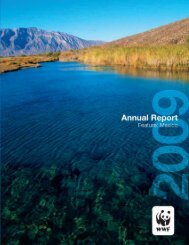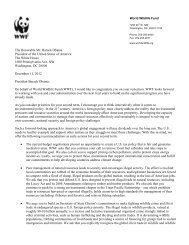Amazon - World Wildlife Fund
Amazon - World Wildlife Fund
Amazon - World Wildlife Fund
Create successful ePaper yourself
Turn your PDF publications into a flip-book with our unique Google optimized e-Paper software.
MEG Deforestation or forest destruction is responsible for 15<br />
percent of the total greenhouse gas emissions on the planet. And<br />
the <strong>Amazon</strong>’s about half of that. That’s a significant percentage<br />
of total global emissions and if you were to vaporize the <strong>Amazon</strong><br />
tomorrow, the amount of carbon released into the atmosphere<br />
would be equivalent to 10 to 15 years of man-made emissions.<br />
TOM The <strong>Amazon</strong> also plays an important role in global hydrology.<br />
It actually makes half of its own rain, but the impact of<br />
that is quite far-reaching. As the moisture hits the high wall of<br />
the Andes, some of it deflects south and some of it north. This<br />
moisture goes south right into important agro-industrial areas in<br />
southern Mato Grosso, Sao Paulo, and even northern Argentina.<br />
JASON So when you deforest the <strong>Amazon</strong>, you’re disrupting<br />
this “bellows” that sends rain from the east to the west.<br />
Through a cycle of evaporation, it produces rainfall about six<br />
times by the time you get to the mountains. And what goes<br />
south about nine months later is a perfect indicator for how<br />
much rain there’s going to be for grain production in South<br />
Africa. And the part that goes north, there’s even speculation<br />
that this influences the Gulf Stream. The rain forest has an<br />
enormous impact on global climate.<br />
TOM In the reverse, climate change has an enormous impact on<br />
the rain forest as well. But this is a slightly complicated picture,<br />
and also a hugely important and scary one. With the normal climatic<br />
cycle, El Niño-La Niña, you alternate between wet and dry<br />
periods. With El Niño you get really dry at times in the <strong>Amazon</strong>.<br />
Superimposed on that is human-driven climate change. And the<br />
Hadley Centre, which is one of the five major computer centers<br />
doing climate modeling, showed that with just a slight rise in<br />
global temperature, you could actually get a reduction in rainfall<br />
in the south and the eastern <strong>Amazon</strong>, essentially to a point<br />
where it no longer can support rain forests and would gradually<br />
become savanna. That’s called <strong>Amazon</strong> dieback.<br />
They first projected this would occur at a 2-1/2 degrees increase<br />
in global temperature. Then last year they revised it to<br />
2 degrees. On top of that, the <strong>World</strong> Bank did a million-dollar<br />
study last year in which, for the first time, modeling combined<br />
climate, deforestation and fire, each of which has been known<br />
to have some kind of impact. And that study suggests that you<br />
could have a tipping point for dieback at 20 percent deforestation.<br />
It is currently at 18 percent.<br />
JASON Certainly deforestation is one of the major threats to<br />
the <strong>Amazon</strong>. About 75 to 80 percent of the <strong>Amazon</strong> that has<br />
been cut is related to cattle and beef production. Ranchers cut<br />
If recent trends do not change, the <strong>Amazon</strong> could see dramatic changes<br />
over the next two decades. These maps show scientists’ predictions of<br />
ongoing deforestation. The worst of it occurs along roads.<br />
trees because that is a way they can make a living, by turning<br />
forest into pasture. But what if trees had a value? What if carbon<br />
payments became significant enough that trees actually<br />
had more value as trees than as cleared pasture to grow beef?<br />
Right now, some ranchers in Brazil suggest that with carbon<br />
even at 50 cents to $1 a ton, they would make more money selling<br />
carbon than selling beef.<br />
That’s a whole new ball game. That’s a fundamentally different<br />
issue where ranchers could be convinced not to cut. Why would<br />
you cut trees if you were actually reducing your assets?<br />
MEG I want to point out that what’s underlying the agricultural<br />
expansion and that threat to the <strong>Amazon</strong> are the expanding<br />
global markets for soy and for beef as the middle<br />
class expands globally and we have more people who want<br />
to eat meat. Soy is used as a feed for livestock. And beef is a<br />
popular export. So rising affluence around the world is the<br />
root cause of the agricultural expansion.<br />
Maps by WWF-Peru based on Soares-Filho et al 2006<br />
Soybeans with rotary irrigation system<br />
Peach palm<br />
© EDWARD PARkER / WWF-cAnon<br />
© DiEGO M. GARces / WWF-cAnon<br />
Macaw<br />
Bushmaster snake<br />
© ChrisTOPhER MuRRAy © Anand ShARMA<br />
6 worlDWildliFE.ORG/pulse Pulse: The hEART of consERvATion 7



